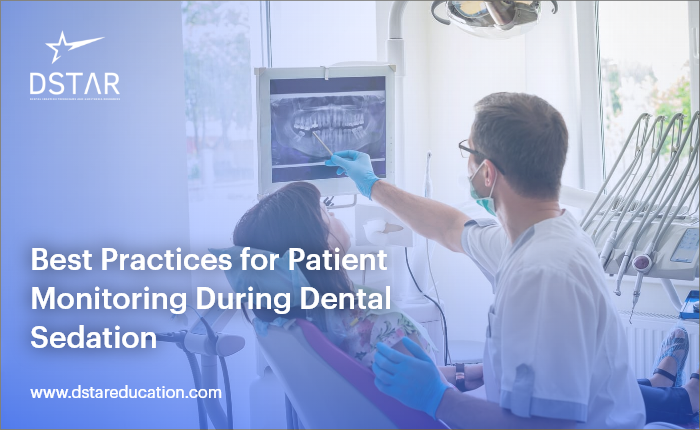Effective patient monitoring is fundamental to safe and compliant dental sedation. Every sedated patient requires continuous evaluation of vital functions to detect early warning signs of adverse reactions or over sedation. Regulatory bodies such as the American Dental Association (ADA), American Society of Anesthesiologists (ASA), and the Texas State Board of Dental Examiners (TSBDE) emphasize that vigilant patient monitoring systems reduce complications, improve recovery outcomes, and uphold professional standards of care.
Whether providing minimal, moderate, or deep sedation, dentists must understand how to apply objective data and clinical observation to maintain airway patency, cardiovascular stability, and responsiveness throughout every procedure.
Understanding the Goals of Patient Monitoring During Dental Sedation
Patient Monitoring During Dental Sedation involves more than simply tracking numbers. The purpose is to integrate clinical observation, montioring devices, and pharmacologic knowledge to maintain patient safety.
The primary goals include:
- Detecting early signs of over sedation before respiratory or cardiovascular compromise develops.
- Ensuring the sedated patient retains protective airway reflexes when appropriate to the sedation level.
- Identifying changes in oxygenation, ventilation, and hemodynamics using calibrated patient monitoring systems.
- Guiding drug titration and recovery decisions based on real-time physiological feedback.
Failure to maintain accurate monitoring represents a violation of TSBDE sedation standards and may result in disciplinary action or suspension of sedation privileges.
Core Components of a Patient Monitoring System
Each patient monitoring system used in dental sedation should measure vital physiologic parameters required by the patient’s sedation level.
These parameters include:
- Oxygenation: Continuous pulse oximetry is mandatory for all sedation levels. Normal SpO₂ values should remain above 94%. Any sudden decline signals hypoventilation, hypoxia, or airway obstruction.
- Ventilation: Observation of chest movement alone is insufficient. Capnography (end-tidal CO₂ monitoring) is now required by TSBDE for moderate, deep, and general anesthesia permits. ETCO₂ levels typically range from 35-45 mmHg; sustained increases may indicate hypoventilation, increased temparature, Malignant hyperthermia, or an incompetent anesthesia machine respiratory valve.
- Circulation: Blood pressure and heart rate must be monitored and recorded at defined intervals. Automated noninvasive monitors or manual sphygmomanometers may be used. Abnormal readings should trigger immediate evaluation of anesthetic depth and oxygen delivery.
- Temperature: Hypothermia may develop during prolonged or deep sedation cases, particularly in pediatric patients. Continuous or periodic temperature assessment helps prevent metabolic disturbances.
- Neuromuscular Response and Consciousness: Monitoring verbal response, purposeful movement, or eye opening provides clinical evidence of sedation depth. Absence of these signs in a patient expected to remain responsive signals over sedation.
The integration of these measurements defines an effective patient monitoring protocol and ensures compliance with regulatory standards.
Best Practices for Monitoring Sedated Patients Across Sedation Levels
Different sedation levels demand specific monitoring standards. Texas divides sedation permits into four categories, each with increasing requirements for both technology and staff qualifications.
Level 1: Minimal Sedation
Patients remain awake and responsive to verbal commands. Primary risks involve mild respiratory depression from oral sedatives or nitrous oxide.
Best practices include:
- Use pulse oximetry throughout the procedure.
- Documenting blood pressure and pulse at least every 15 minutes.
- Maintaining direct visual contact with the sedated patient at all times.
- Recording the start and stop times of sedation agents.
Level 2: Moderate Sedation (Oral or Enteral Route)
Patient monitoring during dental sedation at this level requires continuous visual assessment and external physiologic monitoring using devices such as pulse oximetry, blood pressure cycling, and capnography when indicated.
Standards include:
- Continuous pulse oximetry and intermittent capnography, if available.
- Blood pressure and heart rate every 5-10 minutes.
- A precordial stethoscope or equivalent to assess ventilation.
- Availability of reversal agents such as flumazenil or naloxone.
The operator must be certified in BLS and ACLS and or PALS, and a trained assistant must remain present throughout the procedure.
Level 3: Moderate Sedation (Parenteral/IV Route)
When sedation agents are administered intravenously, physiological responses change more rapidly, increasing the risk of over sedation.
Best practices include:
- Continuous ECG monitoring for arrhythmia detection.
- Capnography for ventilation evaluation.
- Documentation of every drug dose and time of administration.
- Continuous pulse oximetry and frequent assessment of the consciousness level.
At this stage, the patient monitoring system should include audible alarms, and staff must be trained to interpret data trends and intervene promptly.
Level 4: Deep Sedation and General Anesthesia
Deep sedation involves significant depression of consciousness and loss of protective reflexes. Patient monitoring systems for this level must meet hospital-grade standards.
Requirements include:
- Continuous ECG, pulse oximetry, and capnography.
- Blood pressure at least every 5 minutes.
- A precordial or pretracheal stethoscope for airway sounds.
- Direct supervision by a permit holder qualified in advanced airway management.
- Documented post-anesthesia recovery monitoring until full responsiveness returns.
DSTAR Education emphasizes that maintaining proficiency with monitoring devices is as important as using them. CE programs offered by DSTAR help practitioners interpret real-time data and recognize signs of sedation depth or instability early.
Recognizing Early Signs of Sedation and Over Sedation
The ability to interpret signs of sedation accurately determines patient safety during every procedure. Sedation exists on a continuum, and misjudging its depth can rapidly lead to airway obstruction, hypoxia, or cardiovascular instability.
Early signs of over sedation include:
- Delayed verbal response or unresponsiveness to commands.
- Shallow or irregular respirations.
- Decreased oxygen saturation (SpO₂ < 92%).
- Cyanosis or pallor.
- Bradycardia or hypotension.
- Snoring or paradoxical chest movement indicates partial airway obstruction.
Immediate corrective action should include airway repositioning, oxygen supplementation, and reduction or discontinuation of sedative administration.
Providers must also remember that over-sedation in pediatric or medically compromised patients can manifest abruptly, even with minimal drug escalation. Maintaining situational awareness and constant monitoring of all parameters reduces emergency interventions.
Integrating Patient Monitoring into Clinical Workflow
An effective patient monitoring system functions as part of a larger safety framework. Continuous data must be documented, interpreted, and integrated into active decision-making.
Best practices for patient monitoring include:
- Baseline Recording: Document preoperative vitals before drug administration.
- Trend Analysis: Compare real-time data to baseline rather than absolute values.
- Communication: Assign clear roles for monitoring, documentation, and drug administration.
- Redundancy: Use both manual observation and automated systems for cross-verification.
- Recovery Phase Monitoring: Continue observation until the sedated patient meets discharge criteria such as stable vital signs and full responsiveness.
Each record must include the procedure’s start and end time, total drugs administered, and any abnormal findings. During a TSBDE inspection, incomplete monitoring documentation is considered a regulatory violation.
Continuing Education and DSTAR’s Role in Monitoring Excellence
Professional competency in patient monitoring during dental sedation depends on ongoing education. The TSBDE mandates sedation permit holders to complete continuing education (CE) in airway management, pharmacology, and emergency preparedness.
DSTAR Education offers advanced CE programs focusing on real-time monitoring interpretation, airway emergency management, and updates on sedation monitoring technology. These courses help dentists meet their renewal requirements while improving clinical proficiency.
By aligning CE participation with the best practices for patient monitoring, providers ensure compliance, strengthen clinical judgment, and reduce malpractice exposure.
Conclusion
Patient monitoring represents the foundation of safe and compliant dental sedation. Whether administering minimal nitrous oxide or deep intravenous sedation, vigilance, documentation, and rapid recognition of signs of sedation depth are essential to preventing over sedation and maintaining patient safety.
By integrating technology, clinical skill, and ongoing education through institutions like DSTAR Education, dental professionals meet the highest standards of regulatory compliance and clinical excellence. Best practices for patient monitoring are not optional—they define the difference between adequate care and exceptional dentistry.
FAQs
Q. What are the essential components of a patient monitoring system?
A complete patient monitoring system includes pulse oximetry, capnography, ECG, blood pressure, and temperature measurement devices. These ensure real-time tracking of oxygenation, ventilation, and circulation.
Q. How can I identify early signs of over sedation?
Delayed responses, shallow respirations, desaturation, or bradycardia are signals of over sedation. Immediate airway support, oxygen administration (if not already being provided), discontinuation of sedation medications, and administration of reversal agents are important responses.
Q. What is the difference between patient monitoring in minimal and deep sedation?
Minimal sedation requires basic monitoring such as SpO₂ and blood pressure, while deep sedation demands SPO2, BP, ECG, ETCO₂, and advanced airway assessment under direct supervision.
Q. Why is capnography important during dental sedation?
Capnography provides the earliest indicator of ventilatory failure. A sudden rise in end-tidal CO₂ or a complete loss of CO2 waveform can precede visible respiratory distress, allowing timely intervention.
Q. What are the discharge criteria for a sedated patient?
A sedated patient should achieve baseline vitals, oxygen saturation above 94%, and full cognitive recovery before discharge. Continuous observation must be documented until these are achieved.
Q. How does DSTAR Education support sedation monitoring compliance?
DSTAR Education offers CE programs covering airway management, monitoring technology, and TSBDE regulatory updates to help dentists stay compliant with sedation standards.
Q. What are the best practices for patient monitoring documentation?
Record baseline vitals, drug doses, continuous readings, and any abnormal events. Maintain logs for inspection readiness and quality assurance.
References
- American Dental Association. Guidelines for the Use of Sedation and General Anesthesia by Dentists. Chicago, IL: ADA.
- American Society of Anesthesiologists. Standards for Basic Anesthetic Monitoring. ASA House of Delegates.
- Texas State Board of Dental Examiners. Title 22, Texas Administrative Code, Part 5, Chapter 110. Austin, TX: TSBDE.
- American Heart Association. BLS and ACLS Provider Manual (11th ed.). Dallas, TX: AHA.
- Centers for Disease Control and Prevention. Guidelines for Safe Sedation and Airway Monitoring. U.S. Department of Health and Human Services.
- American Academy of Pediatric Dentistry. Monitoring and Management of Pediatric Dental Patients During Sedation. AAPD.
- Journal of Dental Anesthesia and Pain Medicine. Clinical outcomes of patient monitoring during sedation in dentistry, 22(4), 251–266.
 Take Free TSBDE Anesthesia Jurisprudence Practice Exam Now!
Take Free TSBDE Anesthesia Jurisprudence Practice Exam Now!












